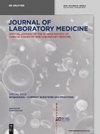冠状动脉搭桥术围手术期高敏心肌肌钙蛋白I(access hs-TnI)对主要不良心脏事件的最新临界值:来自单个心脏中心的回顾性研究
IF 1.8
4区 医学
Q4 MEDICAL LABORATORY TECHNOLOGY
引用次数: 0
摘要
摘要目的探讨冠状动脉旁路移植术(CABG)围手术期心肌肌钙蛋白I对重大心脏不良事件(mace)的最新临界值。方法选取200例患者,根据术后12天内mace的发生情况分为mace组和非mace组,在术前心脏科会诊期间进行完整的基线病史调查、体格检查、12导联心电图(ECG)和实验室检查。采用Beckman DXI800全自动化学发光免疫分析仪检测血清hs-TnI、肌血红蛋白、肌酸激酶MB亚型(CK-MB)和b型利钠肽水平。结果200例患者分为mace组(n=10)和非mace组(n=190)。基于受体-操作特征分析,预测围手术期mes的最佳术后4-6小时hs-TnI、CK-MB和MYO关节临界值分别为2,622.3 pg/mL、17.9 ng/mL和190.2 ng/mL。AUC为0.779(95%置信区间:0.622-0.937;P <0.05),敏感性为80.0%,特异性为74.0%。围手术期hs-TnI、CK-MB、MYO水平超过关节临界值时,mace发生率显著升高(Log rank p<0.05)。Cox回归分析显示,血脂异常、左室射血分数<50%、hs-TnI水平、肌血红蛋白水平是冠脉搭桥后发生mace的主要危险因素(p<0.05)。结论hs-TnI水平为2622.3 pg/mL, CK-MB水平为17.9 ng/mL, MYO水平为190.2 ng/mL是预测mace的临界值。血脂异常、左室射血分数<50%、hs-TnI水平、肌血红蛋白水平是冠脉搭桥后mace发生的主要危险因素。本文章由计算机程序翻译,如有差异,请以英文原文为准。
The latest cutoff value of high-sensitivity cardiac troponin I (access hs-TnI) for major adverse cardiac events during the perioperative period of coronary artery bypass grafting: a retrospective study from a single heart center
Abstract Objectives To investigate the latest cutoff value of high-sensitivity cardiac troponin I for major adverse cardiac events (MACEs) during the perioperative period of coronary artery bypass grafting (CABG). Methods A total of 200 patients, into MACEs and non-MACEs groups according to the occurrence of MACEs over a 12 day postoperative period underwent a complete baseline history survey, physical examination, 12-lead electrocardiogram (ECG), and laboratory examination during a preoperative cardiology consultation. Serum levels of hs-TnI, myohemoglobin, creatine kinase MB isoform (CK-MB), and B-type natriuretic peptide were assessed using a Beckman DXI800 automatic chemiluminescence immune analyzer. Results The 200 patients were classified into the MACEs (n=10) and non-MACEs (n=190) groups. Based on a receiver-operating characteristic analysis, the optimal 4–6 h postoperative hs-TnI, CK-MB, and MYO joint cut-off levels for predicting perioperative MACEs were 2,622.3 pg/mL, 17.9 ng/mL, and 190.2 ng/mL, respectively. The AUC was 0.779 (95% confidence interval: 0.622–0.937; p<0.05) with a sensitivity of 80.0% and a specificity of 74.0%. When the hs-TnI, CK-MB, and MYO levels exceeded the joint cut-off levels, the incidence of MACEs was significantly increased during the perioperative period (Log rank p<0.05). Cox regression analysis showed that dyslipidemia, left ventricular ejection fraction <50%, hs-TnI level, and myohemoglobin level were the main risk factors for MACEs after CABG (p<0.05). Conclusion An hs-TnI level of 2,622.3 pg/mL, CK-MB level of 17.9 ng/mL, and MYO level of 190.2 ng/mL were the cutoff values for predicting MACEs. Dyslipidemia, left ventricular ejection fraction <50%, hs-TnI level, and myohemoglobin level were the main risk factors for MACEs after CABG.
求助全文
通过发布文献求助,成功后即可免费获取论文全文。
去求助
来源期刊

Journal of Laboratory Medicine
Mathematics-Discrete Mathematics and Combinatorics
CiteScore
2.50
自引率
0.00%
发文量
39
审稿时长
10 weeks
期刊介绍:
The Journal of Laboratory Medicine (JLM) is a bi-monthly published journal that reports on the latest developments in laboratory medicine. Particular focus is placed on the diagnostic aspects of the clinical laboratory, although technical, regulatory, and educational topics are equally covered. The Journal specializes in the publication of high-standard, competent and timely review articles on clinical, methodological and pathogenic aspects of modern laboratory diagnostics. These reviews are critically reviewed by expert reviewers and JLM’s Associate Editors who are specialists in the various subdisciplines of laboratory medicine. In addition, JLM publishes original research articles, case reports, point/counterpoint articles and letters to the editor, all of which are peer reviewed by at least two experts in the field.
 求助内容:
求助内容: 应助结果提醒方式:
应助结果提醒方式:


